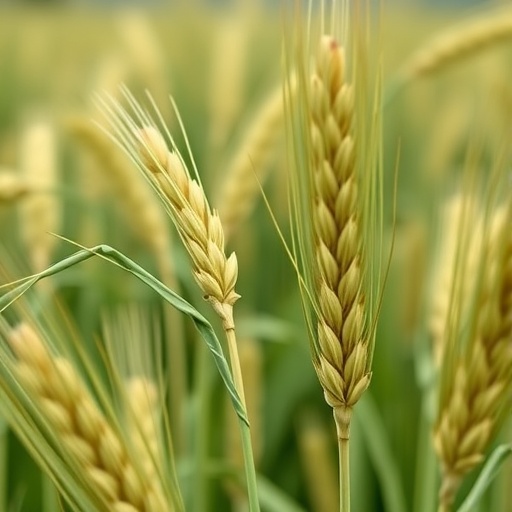In a groundbreaking study published in BMC Genomics, researchers led by Jia, Xu, and Wu have unveiled significant insights into the genetic mechanisms that govern nitrogen use efficiency (NUE) in wheat, particularly emphasizing the prominent role of flag leaf traits. This research is timely and critical, considering the growing global demand for food production, which necessitates enhanced crop performance under constraints like limited nitrogen availability. As nitrogen is a key macronutrient in plant growth, understanding how wheat can optimize its use is vital for sustainable agriculture.
Through a comprehensive genome-wide association study (GWAS), the researchers explored a diverse set of wheat germplasm to identify genetic variants linked to NUE traits. GWAS has become an indispensable tool in agriculture, enabling scientists to link phenotypic traits with underlying genotypes. By analyzing the genotypes of different wheat varieties alongside their corresponding phenotypes, the study was able to pinpoint specific loci associated with desirable traits, such as the efficiency of nitrogen utilization and flag leaf morphology.
Linkage mapping further complemented the GWAS findings by allowing the researchers to create a more refined genetic map of the wheat genome. This technique is particularly useful in identifying genetic regions that control important agronomic traits. Through meticulous analysis, they were able to localize candidate genes that could potentially be harnessed in breeding programs aimed at improving NUE in wheat.
Flag leaves play a crucial role in photosynthesis and overall plant productivity, making them a focal point of this research. The study emphasized that variations in flag leaf traits can lead to significant differences in how effectively wheat plants absorb and utilize nitrogen. By dissecting the genetic architecture associated with these traits, the researchers believe that significant progress can be made toward breeding wheat varieties that are not only high-yielding but also resource-efficient, paving the way for more ecologically sustainable farming practices.
Additionally, the transcriptomic analysis performed in this study adds another layer of depth to the findings. By examining gene expression levels in response to nitrogen treatment, the researchers were able to identify which candidate genes are upregulated or downregulated under varying nitrogen conditions. These insights shed light on the dynamic regulatory networks that underpin NUE, revealing potential targets for genetic manipulation.
The implications of this research extend far beyond theoretical knowledge. As global populations continue to rise, and with it, the challenge of feeding billions of people grows more acute, scientists are under increasing pressure to develop crops that can thrive in suboptimal conditions, including limited nutrient availability. The integration of genomic tools to elucidate the genetic bases of NUE traits in wheat signifies a monumental step toward addressing these challenges.
Moreover, this study highlights the potential for utilizing advanced breeding techniques such as CRISPR-Cas9 gene editing. By understanding the specific genes responsible for enhanced nitrogen use efficiency, plant breeders can tailor wheat varieties with precision, ensuring improved agricultural resilience and productivity. This approach could transform how farmers manage fertilization practices, potentially leading to lower nitrogen input costs and reduced environmental impacts from fertilizer runoff.
The findings of this study could also have profound implications for climate-smart agriculture. With increasing climate variability, crops that can efficiently utilize nitrogen are less likely to become stressed. Enhancing NUE traits in wheat can help ensure stable food production even in the face of changing environmental conditions, thus supporting food security.
Collaborative efforts among geneticists, agronomists, and farmers will be essential to translate these scientific advancements into practical solutions. Field trials will be crucial for validating the effectiveness of the identified traits and genes under real-world agricultural conditions. Ensuring that these innovations reach the farmers who need them most is a challenge that stakeholders across the agricultural sector must address.
As the demand for sustainable agricultural solutions grows, this research brings hope that advancements in genomic science can be harnessed to promote not only higher wheat yields but also practices that respect and preserve the environment. The multifaceted approach of combining GWAS, linkage mapping, and transcriptomics will undoubtedly set a precedent for future studies aimed at maximizing crop efficiency and sustainability.
In conclusion, the research undertaken by Jia, Xu, and Wu represents a significant stride toward enhancing nitrogen use efficiency in wheat through concerted genomic analyses. The identification of candidate genes associated with flag leaf traits sheds light on the complex interplay of genetic factors influencing NUE. This pioneering work has far-reaching implications for improving wheat production systems, ensuring agricultural sustainability, and meeting global food demands in the years to come, establishing a critical bridge between cutting-edge research and practical agricultural applications.
Subject of Research: Nitrogen use efficiency in wheat through genetic analysis of flag leaf traits
Article Title: Genome-wide association study, linkage mapping and transcriptomic analysis revealed candidate genes with the flag leaf traits associated with nitrogen use efficiency in wheat
Article References:
Jia, Y., Xu, N., Wu, J. et al. Genome-wide association study, linkage mapping and transcriptomic analysis revealed candidate genes with the flag leaf traits associated with nitrogen use efficiency in wheat.
BMC Genomics 26, 833 (2025). https://doi.org/10.1186/s12864-025-12025-7
Image Credits: AI Generated
DOI: 10.1186/s12864-025-12025-7
Keywords: nitrogen use efficiency, wheat, genome-wide association study, flag leaf traits, transcriptomic analysis, genetics, sustainable agriculture, crop improvement




